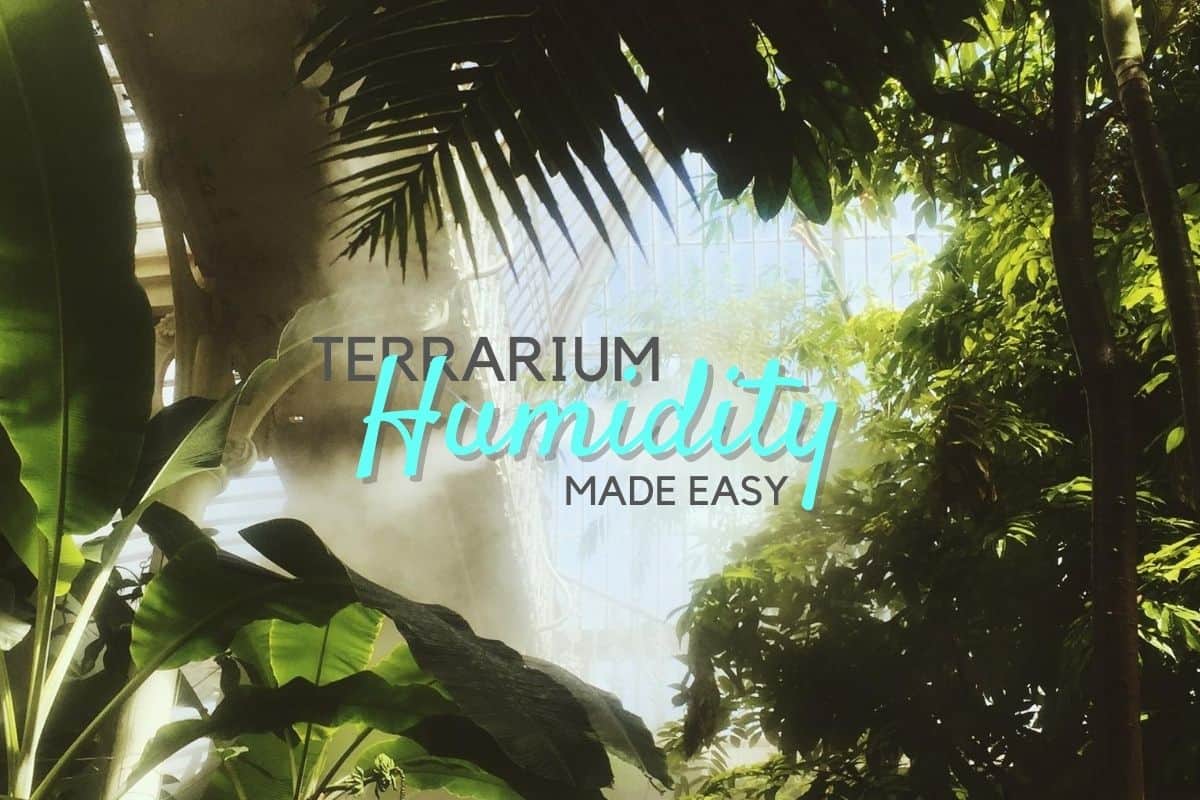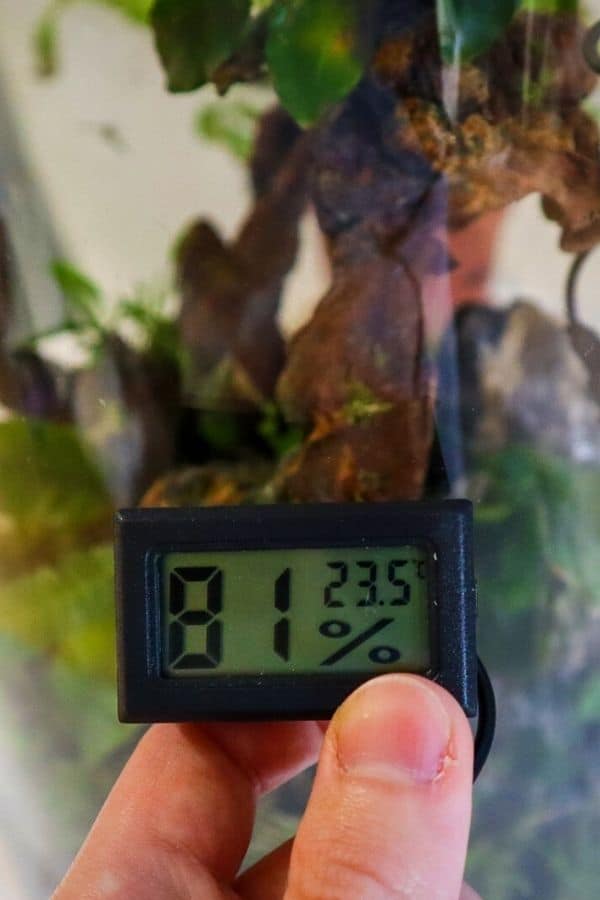How To Increase Humidity Planet Zoo
Humidity is a primal role of what makes a terrarium such a valuable horticultural tool.
The ability to trap moisture is key to creating the tropical surround that allows u.s. to abound such interesting and exotic plants.
But, humidity is a fickle mistress…
She'southward as quick to change as the weather, and when it comes to plants she can quickly go from platonic to problematic.
After all, humidity is dependent on many factors, and maintaining an even balance can be tricky as we progress through the different seasons.
In this article, we're going to break down the concept of humidity into digestible chunks that are super helpful to know, so you can learn to control it to fit the state of affairs.
Let'south dive in.

This page may contain affiliate links that let us to brand a small commission (at no further cost to yourself). 💚 Thanks for helping to support the tribe!
- Understanding Terrarium Humidity
- How to Increase Humidity in a Terrarium
- How to Decrease Humidity in Terrariums
- How to Check Humidity in a Terrarium
- The Automated Pick
- Over to Yous
Understanding Terrarium Humidity
Humidity is simply a figure that's used to describe the corporeality of water vapor in the air.
It seems like a straightforward concept but information technology tin can be expressed in a variety of ways, and if you're working information technology out yourself the calculations can be a niggling disruptive…
That's why we're keeping it unproblematic (using tricks and tools to mensurate the humidity for the states) and but discussing what we demand to know for terrariums.
Relative Humidity
Usually, when we hear humidity levels on the morning weather report, nosotros're being told a percentage figure. That % effigy is a relative humidity level, and it'southward pretty much the but one nosotros're interested in.
It's a reflection of how close the air is to becoming saturated (with 100% being the maximum).
As temperatures modify, the amount of h2o vapor the air tin hold will also modify. Relative humidity accounts for that, which is why nosotros use it.
Almost high humidity terrarium plants are going to be looking for in a higher place 50% relative humidity.

This isn't also difficult to accomplish in a terrarium if y'all take enough warmth, and considering tropical plants typically need a reasonably high temperature too – information technology kind of comes with the territory.
So, by understanding how relative humidity is afflicted by different factors, nosotros can use them to our advantage to control the humidity in our terrariums.
How to Increase Humidity in a Terrarium
When we're talking nigh ways to humidify a terrarium, they tend to fall into two unlike categories.
- Processes that can help you saturate the air.
- Processes that can drive up the potential relative humidity effigy.
The blazon you need to utilize will depend on your abode and terrarium weather condition.
For instance, if the temperature in your abode is typically warm and highly regulated, y'all'll probably just need help in further saturating the air (as the capacity of that air to hold moisture is already loftier).
Whereas, if the temperature in your closed terrarium is low or prone to change a lot, you lot may need assist in increasing that saturation threshold. Later on all, there's not much value in saturating the air if the maximum it can concur is too depression.
#i Increase Oestrus
Equally we've discussed, warmer air tin hold more moisture. So, it stands to reason that the well-nigh obvious style to increment humidity is to warm up the air. Simple!
In fact, it works two-fold, as the extra heat also makes water more readily evaporate.
There are lots of means to increase the temperature within your terrarium.
- The most counterbalanced fashion is to only crank upward the central heating. Warming upwardly your terrarium and the room information technology'due south in, will balance condensation levels too by equalizing temperatures across the drinking glass.
- Movement the terrarium to a brighter spot (merely still out of straight sunlight) to blot more of the Sun's rays. Take care with this one though, equally the trapped oestrus can speedily build up.
- Pop your terrarium on top of a plant heating mat. This was my solution through the winter months, and it works peculiarly well if you take a drainage layer and a reservoir of water at the bottom.
#2 Increase Water
Adding more water into the arrangement would appear to be the adjacent obvious pace, and it works… up to a point.
Having extra h2o available in the system can indeed fuel the evaporation procedure if temperature atmospheric condition are suitable, only it tin't drive the potential maximum humidity upwardly across what the conditions permit.
That being said, having a drainage layer in place at the bottom of your terrarium can help a lot, equally that reservoir of water tin can further feed the system.
Only note, that a deeper drainage layer isn't more than effective than a shallow 1 when it comes to evaporation.
H2o volition only evaporate from the surface, so wider containers with more surface expanse exposed to the air should evaporate more, merely deeper water won't make a difference.
#3 Use the Right Substrate
Terrarium substrates with a high potential for water retention can significantly boost ambient humidity where at that place's sufficient warmth and moisture (see our terrarium substrate guide for more info).
The likes of sphagnum moss and coconut coir accept huge capacities to hold moisture, and they tin release that slowly into the air in an even manner.
Plus, your organization can concur more water overall without waterlogging your plants.
When information technology comes to growing tropical plants in a terrarium, you'll almost certainly do good from a substrate that retains wet well. So, I would look to include these materials in your substrate mix anyway.
#4 Add More Plants
It'south easy to forget that plants play a primal part in this living water cycle too.
More plants = More transpiration = More h2o evaporation
If h2o is the fuel for your terrarium, and so your plants are the engine to create humidity. Then, the more full your terrarium is with plants, the easier information technology is to maintain that high humidity level necessary for tropical plants.
Meet our Terrarium Plant Index if you need aid filling your terrarium with plants!
Due to its large surface surface area and density, moss is particularly good for increasing the amount of institute biomass in your terrarium without having to stuff it to the brim with plants (part of the reason moss terrariums are so easy to look later).
As if you need any reason to add more than moss, correct?

#v Add A Misting Organization or Fogger
Finally, in that location's the artificial way to increase humidity.
Terrarium humidifiers come in a variety of options. Both mechanisms will periodically spray the terrarium with a fix corporeality of moisture, it's just actually the aesthetic that changes when you're choosing between a fogger or mister.
The mechanism is going to periodically spray water into the terrarium from an external reservoir. It's super helpful in larger ventilated terrariums where humidity tin be lost, but it'll quickly oversaturate a smaller or fully sealed terrarium.
How to Decrease Humidity in Terrariums
This probably isn't going to be quite as common a problem, simply for more temperate terrariums full of plants that don't similar high humidity, in that location are ways to reduce information technology.
Virtually of them are the exact opposite of the to a higher place suggestions, just likewise one very easy additional method.
- Increase ventilation – opening up your terrarium periodically (or permanently if your plants allow it) will permit water vapor to escape, and very effectively prevent the build-up of humidity.
- Cool your terrarium – reduce the air's capacity to hold water and reduce evaporation rates at the same time.
- Use a coarser substrate – the less h2o your substrate can retain, the less water you can maintain the organisation at.
How to Check Humidity in a Terrarium
When it comes to checking the humidity levels in your terrariums, There'south the scientific fashion and the visual way.
The quickest manner is to but detect the amount of condensation on the glass.
If water is condensing, you tin assume the air is near its saturation indicate. Of course, at that place are actress factors to consider here – as the cooler glass surface causes condensation – but you lot can read more about that in the terrarium condensation guide.
You tin can at least tell that your terrarium has a reasonable level of humidity via condensation.
If you want exact figures, you're going to demand a hygrometer (substantially a terrarium humidity sensor). They're adequately inexpensive, and I picked up one from Amazon for very cheap.
The Automated Option
For those who love a technical solution, in that location are fully automatic terrarium temperature and humidity controllers on the market.
For example, when combined with a mister and a fan, the REPTI ZOO EZ Smart Thermo-Hygrostat Timer Controller seems to exist capable of regulating most terrarium conditions.
It'southward probably overkill for most plant terrariums, but for vivariums with animals or large plant terrariums that demand meaning regulation then I tin can see the benefit. I approximate it gives you peace of mind too.
Over to You
Do y'all have whatever issues maintaining humidity? It can seem like a hard thing to wrangle but there's always a solution.
If you need more guidance getting all of the elements of your terrarium just right – bank check out our Essential Guide to Tropical Terrariums!
Source: https://terrariumtribe.com/plant-terrarium-humidity/

0 Response to "How To Increase Humidity Planet Zoo"
Post a Comment